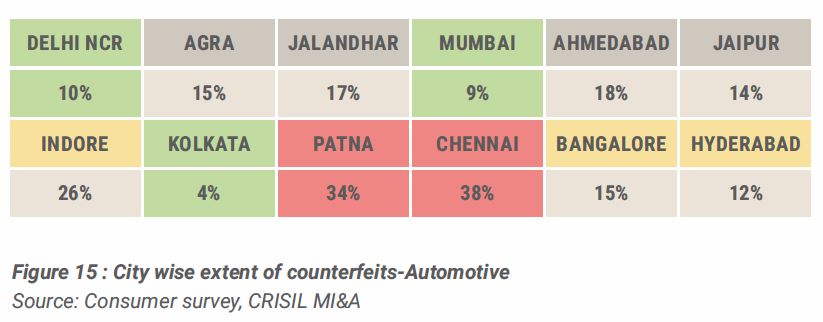
PHARMACEUTICALS
According to CRISIL MI&A, the Rs 3,136 billion pharmaceutical market (fiscal 2021 estimate) is projected to reach Rs 3,607 billion in fiscal 2023. Counterfeiting is prevalent in pharmaceutical products whose volumes are very high and value is high. The major reasons of counterfeiting are leakages in the supply chain and demand and supply gaps. Even though India is one of the largest manufacturers of generic medicines across the globe, the penetration of organised pharmaceutical chains within the country is limited owing to lower reach of healthcare services, a poor supply chain network and high costs. The demand-supply gap and low affordability ultimately lead to counterfeit/ grey market of medicines, especially for lifestyle diseases. According to the consumer survey, about 25% of the total respondents willingly purchased counterfeit/duplicate pharma products owing to unavailability of original brands and lower costs.

FAST-MOVING CONSUMER GOODS (FMCG)
India's fourth-largest industry, fastmoving consumer goods (FMCG), is driven by a growing preference for branded products, easy access and changing lifestyles. The urban segment is the largest contributor (~55%) to the overall FMCG sector in India. As per CRISIL MI&A, the FMCG market in India was valued at Rs 4,500 billion in FY 2021, with packaged food accounting for 50%, and personal and home care segments for 30% and 20%, respectively. Counterfeiting in the FMCG segment is highly prevalent as per the industry research and consumer survey, it is perceived to be as high as 25-30%. The level of harmfulness is perceived to be higher for FMCG products, especially in the food segment, yet about 42% of the consumers willingly purchased counterfeit FMCG products as per the consumer survey. About 28% of the survey participants have come across counterfeit FMCG products at least once.

AUTOMOTIVE
The automotive industry in India is one of the largest in the world, and accounted for 7.1% of the country's GDP for fiscal 2021. The sector has grown sharply on rising demand, thereby prompting automakers to undertake considerable investments. As per CRISIL MI&A, total passenger vehicles sold in India stood at 3.07 million in fiscal 2022, and commercial vehicles and two-wheelers, 0.7 million and 13.45 million, respectively. As per a report by the Ministry of Road Transport and Highways (MORTH) and the Society of Indian Automobile Manufacturers Association (SIAM), 20% of road accidents in India were because of mechanical failure of auto components, with several of these accidents on account of faulty and counterfeit parts. Yet, India lacks mandated safety standards for aftermarket products because of which import of counterfeit products cannot be checked, and neither is it possible to gauge the unorganised sector's production and trading of counterfeit parts.

APPAREL
The domestic readymade garment (RMG) industry in India was estimated at Rs 2,653 billion in fiscal 2021, and exports, ~Rs 907 billion. By fiscal 2024, the domestic RMG market is projected to reach Rs 3,800 billion, which is a growth of 18-23% CAGR over fiscal 2022. Apparel is one of most counterfeit products globally, with counterfeiters copying famous and expensive brands. The level of counterfeiting in this segment is expected to be between 30-40%, as per CRISIL's consumer survey. Unlike other industries, it is a easier to make fake fashion products; counterfeiters replicate the look and put the brand's name on it. Also, the willingness to purchase counterfeit products among consumers is the highest in this segment, and perception of harmfulness is the lowest, as per the consumer survey.

CONSUMER DURABLES
The consumer durables industry can be broadly classified into two segments: consumer electronics and consumer appliances. Consumer electronics consist of mobiles, televisions, music players, etc. Consumer appliances can be further categorised into brown goods and white goods. White goods include refrigerators, washing machines, airconditioners, speakers, air coolers, and audio equipment. Brown goods include mixers, grinders, microwave ovens, iron, electric fans, cooking range, chimneys, etc. As per industry sources, the counterfeit consumer durable products market is growing rapidly with the increase in penetration of consumer durables in rural areas. Around 4.4% of the consumer complaints filed with the National Consumer Helpline from January to September 2018 related to fake/spurious/duplicate products.

AGRO PRODUCTS
One of the largest sectors in India, agriculture contributed 20.2% to the GDP in fiscal 2021. It also provides employment to many people. Agrochemicals are a key input required for crop protection and better yield during both pre- and post-harvest stages. Agro chemicals significantly contribute towards national food security. However, the growth of counterfeit agro products is posing a challenge. The market for counterfeit agro chemicals is perceived to be as high as 30-40%. The counterfeiting in pesticides is highest due to higher volumes; as per a retailer survey conducted by CRISIL, it is 30-35%. The margin on counterfeit products is 30-35%, which makes it a lucrative for distributors and retailers.
